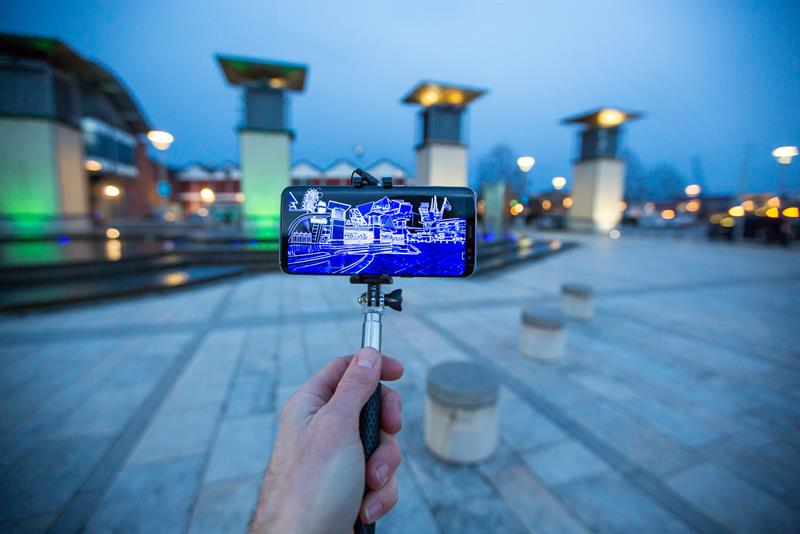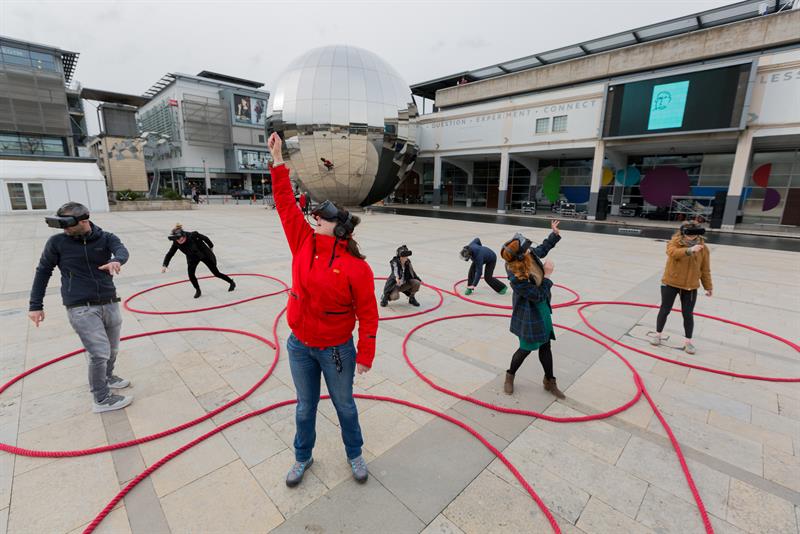Whether it is technology as a tool to create digital artwork, technology as the art itself or technology helping to expand access to the arts there is no question that it is changing the way in which we create and consume art.
Museums and galleries are using technology to help people learn about and enjoy exhibits. It is being used to better understand how people interact with art, analysing how they move through exhibits and, with the use of biometric data, creating displays which have more impact.
None of this is new. Technology has influenced the arts for hundreds of years, whether renaissance painters finding cobalt blue and wanting to experiment with it or the development of photography and the use of the colour spectrum.
The availability of oil paints in a tube, developed in London in the 1840s, is often credited with enabling the French Impressionists to use stunning textures and colours and to complete their paintings inspired by the world around them, away from their studios.
Art reflects society and society, in turn, influences what art is created and today artificial intelligence, technology tools, computers and screen printing are opening up whole new vistas in terms of creativity.
The iPad and Apple Pencil, along with Microsoft’s Surface tablets are inspiring a generation of artists and non-artists as well.
As with all aspects of society, art is no longer exclusively the realm of human beings. AI is now able to create complex works of art itself.
Earlier this year the artist, Anna Ridler, used massive datasets to produce a piece of art. Inspired by the high financial value given to tulips in the early 17th century, she used a data set to create an AI-generated video called ‘Mosaic’ which went on show at the Barbican Arts Centre in central London. Each tulip changed in form and colour depending on bitcoin pricing.
There is no doubt that technology wields great potential for artists – both those who are naturally drawn to being creative, and those who are more into the technology itself.
“Technology and culture have always been inseparable,” according to Vanessa Bellaar Spruijt, a network producer for Network for Creative Enterprise, a multi-hub collaborative project based in Bristol.
“Artists tend to have a different take on the world and how we should be using technology. Art expands and questions our views and creates impact differently to other disciplines.
“Technology designers often have a series of end uses in mind, but won’t have the means to push the boundaries or stress test the technology in ways that interrogate the ethics of its everyday use or its accessibility.”
She believes that the collaboration of arts and culture with technology adds a human element to the development and exploration of it, keeping the work relevant to real people.
“I believe it allows the creation of work where art and technology are inherently linked, as opposed to being art that features technology, or technology being explained by art.”
Sprujit was responsible for a 5G Showcase, ‘Layered Realities’, which was intended to give artists a chance to experiment and create meaningful experiences with 5G, and also test and question how it is or could be applied.
“Through this project we placed arts and culture at the heart of new technologies,” she explains.

Above: Technology is being used to enable museums and galleries to present their collections in innovative ways
Brighton Dome
With the arrival of 5G, a similar project to Layered Realities, devised by Brighton Dome and Festival in partnership with Digital Catapult, has been announced.
Tristan Sharps, Artistic Director of site-specific performance company, dreamthinkspeak, and one of the contributors, is looking to explore the potential of 5G technology.
His company specialises in immersive shows and has used buildings across the UK and around the world to plan and create unique experiences for a live audience.
“As an artist I’ve always used technology in some way to enhance my projects, implementing media such as film and more recently, Bluetooth and VR in my work,” he explains.
“If you sit in a theatre, for example, you’re looking at a stage with actors, props and scenery. If you were to walk up to the stage you’d clearly enter a 2D world designed to be viewed from the stalls. Out work involves creating a physical and interactive world you can enter.
“You enter via the stage, passing through a door or along a corridor, and you can engage with a performer sat at a table or investigate an architectural model of the room you are in.
“My work currently involves working with models and is a theatrical experience. It’s physically real.
“Now technology is allowing me to create all of this in a virtual space. I no longer have to take over an entire building but rather can use VR headsets to allow users to enjoy those experiences.
“Technology is allowing us to do far more but with a smaller physical footprint,” he says.
Technology is also enabling artists to radically change how they interact with their audience.
“I think there has been a ‘sea-change’ in the way in which technology interacts with art,” suggests Sharps.
“Back in 2003, we created a space installing a series of speakers that were interconnected. We then created a soundtrack that was played throughout the space and which was routed through a computer. We were able to create sounds in real-time and affect the reactions of the audience. The difference from today was that they didn’t see or engage with the technology. They weren’t aware of the computer or the speaker system. Today the technology is front and centre.
“The audience can now wear a headset or use a tablet or phone to upload an app to experience the work,” he explains.
As an example, dreamthinkspeak created an immersive piece of work for Hull when it was the UK’s City of Culture. Tablets were handed out to the audience and were used to create a visit to a high-tech South Korean corporation.
“The audience were able to then experience the future of retailing, live gaming and virtual reality in parallel with flashbacks to when the country was under military rule.
“The show was spread across several floors. We needed to ensure that all the audience were engaged. You will always get people who are scared of using technology but, in order to explore the art work, they needed to be at ease with it. To engage with the art the audience needed the tablet and we created an interactive maze, using live tracking to achieve that.”
As Sharps explains, the audience is central to his company’s work.
“The audience is the key, they are on the stage themselves.”
Sharps says it’s important for him to keep abreast of new technology, but readily admits he’s “not the one writing the algorithms”.
Instead, dreamthinkspeak works like a production company. “When we’re developing a project we’ll go from our normal team of 2 up to a team of 100, each with a specific focus and skillset, for example artistic, technical or carpentry.
“I concentrate on the creative ideas and pushing technology into areas that I don’t believe they’ve been pushed into before,” he says.
However, he notes that it is always a collaborative process. “As an artist my imagination tends to speed ahead. I’m told about a certain piece of tech and I have all sorts of ideas of how to deploy it, but of course, it has its limitations.”
Sharps explained that he will leverage the expertise of technicians to understand these limits. This may result in the team devising a way to overcome it, curb his ideas or push them into other avenues.
He gives the example of a recent VR project he developed where he had to make compromises.
“I wanted to create this very detailed 3D world which the audience could inhabit, but I also wanted it so the audience could move around. We connected the headset to a laptop the audience could carry on their backs, but it limited the resolution we could offer. A lot of the detail I wanted couldn’t be included.”

Above: The use of VR is allowing artists to interact very differently with their audiences
Another project under development highlights how technology could completely change how we see and engage with live theatre.
“I’m developing a multi-live streaming project; it’s a production of a Shakespeare play that will be performed in a space with the audience looking down on the action.
“Each audience member will have an iPad, and there will be dozens of cameras embedded throughout the set. The audience will be able to select different cameras from the network to view the performance very differently. They will also be able to use social media to interact with characters in the play and by using a 5G enabled network people, in cafes nearby or at home, will also be able to stream those cameras live at the same time; there should be zero latency.”
It’s a complex project and will involve a large number of cameras.
“The audience will be able to choose camera angles so that there will be a real sense of interaction and you will be able to get away from the passivity of the usual audience experience and get involved.”
Engagement
With bandwidth, resolution and latency having restricted his previous work, Sharps is enthusiastic about the prospects of using 5G.
“I could only have a maximum of 6 headsets in my previous VR experience. Now I’m looking at 100 audience members at any one time, all equipped with a device where content will be triggered and received.”
But beyond the performing arts the use of digital technology means that museums and are galleries are able to present exhibitions and give people access to collections more easily – that’s an overt and obvious gain from the use of technology.
Patrons will be able to look at a painting using an app to see a different perspective of a piece of art or to simply walk through a virtual gallery.
For people like Sharps and Spruijt it’s important that technology opens up the arts to more people.
“Whether in the visual arts or the performing arts, technology has always been part of what we do,” suggests Sharps. “As a company, I see it as natural to use these new tools when they are available. I think the visual arts and film are keener when it comes to embracing technology.”
The big drawback is the expense of using these new forms of technology.
“There is a lot of imagination out there,” says Sharps, “but the technology is expensive to use and there’s a lack of funding to help artists engage with and understand it.”
While technology is helping to bring a new audience to art it is also helping to create a new generation of artists. More people are creating works of art, perhaps that means more poor work will be generated, but a lot of interesting work as well.
Art is also a means to ask questions of technology. In a world where AI is becoming more pervasive art can be used to question its value and allow people to interact with it.
According to Spurijt, “Art can make us feel differently about the world we live in and it will keep doing that with whatever means available, whether it’s a paintbrush, 5G, or an AR headset.”
“Technology is providing us with some wonderful tools,” concludes Sharps. “I would advise artists to get out there, grab and play with it. If you don’t like it then simply go back to using traditional forms. Technology gives artists and audiences alike, a thrilling opportunity to engage with our rapidly changing world.”













